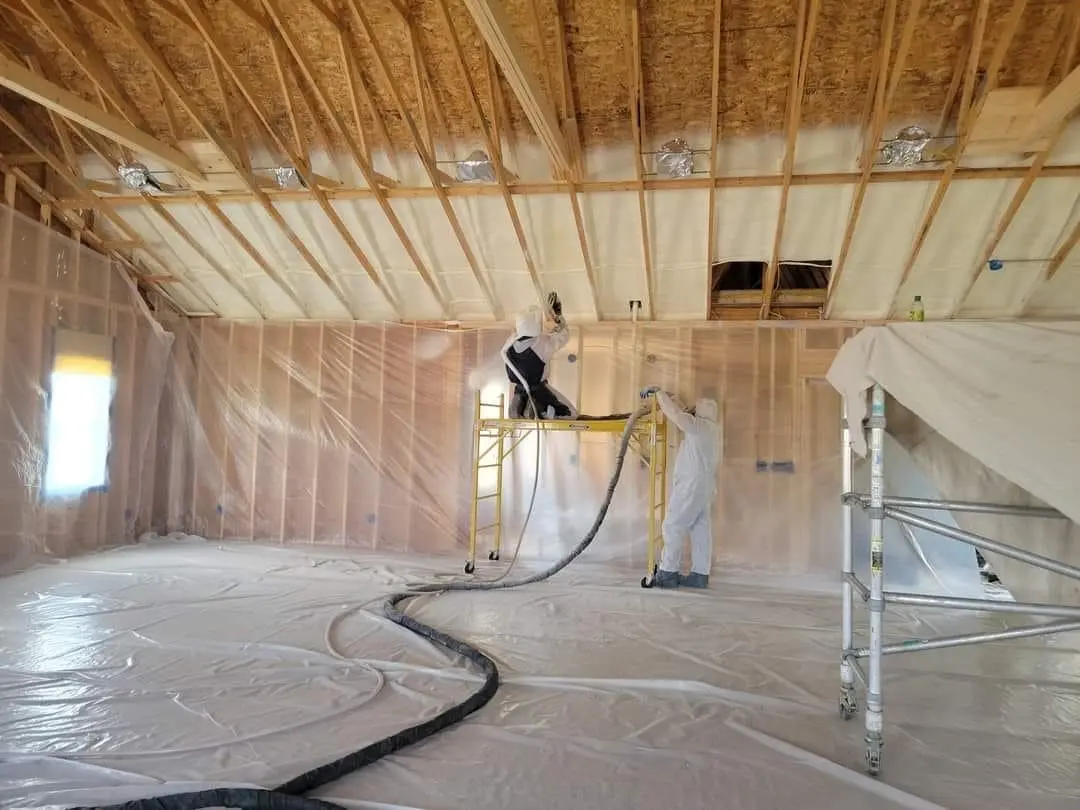What is Spray Foam Insulation Overspray?
Spray foam insulation overspray refers to the excess foam material that can accidentally land on surfaces other than where it is intended. This can happen during the application process when the foam is sprayed, and some of it drifts or falls onto surrounding areas. Overspray can be difficult to remove as it can harden quickly and adhere strongly to surfaces. It is important to take precautions to prevent overspray, such as masking off areas not meant to be insulated, using proper application techniques, and cleaning up any overspray promptly to avoid permanent damage.

Understanding the Composition of Spray Foam Insulation
Spray foam insulation is made up of two types of materials: polyurethane and isocyanate. When these two materials are mixed together, they expand and harden. This helps create a barrier that can effectively insulate a space by sealing off any gaps. The expansion process is crucial as it allows the foam to fill in all the nooks and crannies, ensuring a thorough insulation job.
What Causes Spray Foam Insulation Overspray?
Spray foam insulation overspray happens when the fine mist of the spray foam gets carried by the wind to unintended areas. It can occur due to factors like windy weather, incorrect application techniques, and improperly maintained equipment.
Potential Risks Associated with Overspray
When applying spray foam insulation, overspray can be a common concern. Overspray occurs when the foam doesn’t stick to the intended surface and drifts to unwanted areas. There are potential risks linked to overspray, such as:
- Excess Material: Overspray can waste the insulation material.
- Air Quality: The particles in the overspray can affect the air quality during application.
- Cleanup: Removing overspray can be time-consuming and may require professional assistance to ensure thorough cleaning.
Being aware of these risks can help you take precautions and minimize the impact of overspray when using spray foam insulation.
Dealing with Spray Foam Insulation Overspray: Prevention Tips
Overspray happens when spray foam insulation gets on surfaces where it’s not supposed to be, creating a mess. Here are a few tips to prevent overspray:
- Cover all areas not being insulated with plastic or drop cloths before spraying.
- Use masking tape and paper to protect windows, doors, and other delicate surfaces.
- Keep a damp cloth handy to quickly wipe off any overspray that occurs during application.
How to Clean Up Spray Foam Insulation Overspray
To clean up spray foam insulation overspray, use acetone or a citrus-based cleaner. Acetone works best as it dissolves spray foam quickly. Wear protective gloves and goggles before using acetone. Dip a clean cloth into acetone and gently rub the overspray until it softens and peels off. For stubborn spots, gently scrape the overspray with a plastic scraper. Avoid using metal tools as they can damage the surface. If acetone is not available, a citrus-based cleaner can also break down the overspray. Simply spray the cleaner on the overspray, let it sit for a few minutes, then wipe it away with a clean cloth.
Hiring Professionals for Overspray Cleanup
When dealing with spray foam insulation overspray, it’s crucial to hire professionals for cleanup. Professional cleanup services have the necessary expertise and tools to effectively and safely remove overspray from various surfaces. Attempting to clean overspray yourself can lead to potential damage to property and ineffective removal. Hiring professionals ensures thorough cleanup and minimizes the risk of any lingering overspray causing issues in the future.
Removing Spray Foam Insulation Overspray from Different Surfaces
Spray foam insulation overspray is the excess spray foam insulation that lands on surfaces other than the intended area during application. Removing spray foam insulation overspray can be challenging, but it is essential to maintain the cleanliness and appearance of surfaces. Here are some methods to remove spray foam insulation overspray from different surfaces:
- Soap and water can help remove fresh overspray from nonporous surfaces like glass and metal.
- Mineral spirits or a commercial overspray remover can be used on surfaces like wood and concrete.
- For delicate surfaces like fabric or carpet, it’s best to consult a professional for safe and effective removal.
Remember to act quickly and carefully to prevent the overspray from hardening and becoming more difficult to remove.
Environmental Impact of Spray Foam Insulation Overspray
Spray foam insulation overspray can have a significant environmental impact if not managed properly. When overspray occurs during the application process, it can lead to contamination of soil, water sources, and plant life. Additionally, airborne particles from overspray may contribute to air pollution. Proper containment and cleanup procedures are essential to minimize the environmental impact of spray foam insulation overspray.
Conclusion and Final Thoughts
After considering all the aspects of spray foam insulation overspray, it is crucial to remember that overspray can lead to significant issues if not properly managed. Ensuring proper containment during the application process and promptly addressing any overspray can prevent costly damage and ensure a successful insulation project. Remember, a well-executed insulation job not only enhances energy efficiency but also adds value to your property. So, don’t overlook the importance of managing spray foam insulation overspray for a successful and efficient insulation project.
